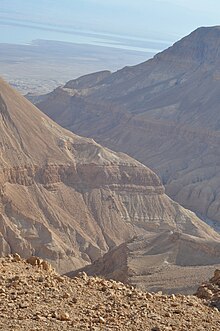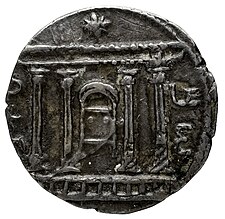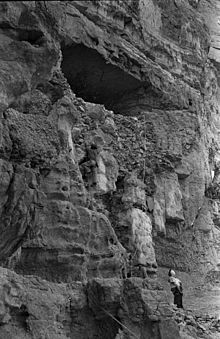
 |
| Part of a series on the |
| Bar Kokhba revolt |
|---|
The Bar Kokhba refuge caves are natural caves that were used for shelter by Jewish refugees during the later phases of the Bar Kokhba revolt. Most of the refuge caves were located in the Judaean Desert, nestled within steep cliffs far away from settlements, many overlooking the Dead Sea and the Jordan Valley. Some were also found in ravines flowing into the Dead Sea, while others were nestled within the Judaean Mountains. [1] Unlike the other two hideout systems used by the rebels, the man-made rock-cut hiding complexes, and the hard-to-reach cliff shelters which often contain hewn installations, the refuge caves remained largely untouched by human intervention. [1] [2]
Jews taking shelter in refuge caves aimed to escape the Roman army during its suppression of the revolt. [1] These caves are thought to have offered sanctuary to those in the eastern Judaean Mountains and the Jordan Valley. [3] Some caves show signs of successful refuge, while others contain skeletal remains of adults and children, indicating deaths due to starvation, thirst, or encounters with Roman forces, as evidenced by the construction of siege camps and the discovery of arrowheads embedded in cave ceilings. [1]
Refuge caves such as the Cave of Letters and Cave of Horror in Nahal Hever, as well as those within Wadi Murabba'at, have yielded many notable archaeological artifacts. These include fragments of Biblical scrolls, documents inscribed in Aramaic and Greek, a variety of weaponry—both locally produced and plundered from the Romans—and coins minted by the Bar Kokhba administration. Moreover, these caves have served as time capsules, preserving household items and valuable objects such as metalwork, pottery, glassware, jewelry, textiles, sandals and keys. [1] [4] These artifacts provide valuable insights into daily life during this tumultuous period, illuminating the experiences of refugees who were prepared for an uncertain future and hopeful for a return to their homes. [5] Among the finds are letters authored by Simon bar Kokhba himself, offering a direct glimpse into the leadership and administration of the revolt. [6]
Older refuge caves
Caves were used for refuge throughout history in the region. Up the southern slope of the Masada cliff, the almost inaccessible Yoram Cave, whose only opening is located some 4 metres (13 ft) above an exposed access path and 100 metres (330 ft) below the plateau, has been found to contain 6,000-year-old barley seeds. Researchers believe that it was a place of short-term refuge for Chalcolithic people fleeing an unknown catastrophe and carrying with them the grain into the desert, the closest place where the barley could have been grown being at least 20 kilometers (12 miles) away. [7] [8] [9]
A refuge cave from Western Galilee, the Kamon Cave, was found to hold large storage jars as well as valuables, placed there at the end of the 4th century BCE during the Diadochi Wars, which wrought havoc in the region including the destruction of nearby Acre. [10]
Regions
Judaean Desert
Over 30 refuge caves have been discovered in the Judaean Desert. [1] These caves are believed to have provided sanctuary for Jewish refugees fleeing from their homes in the eastern Judean Mountains and the Jordan Valley, [3] mainly originated from nearby areas such as Ein Gedi along the western shore of the Dead Sea, villages in the southern Hebron region, and northern locations like Herodium, Jerusalem, and Jericho. Epigraphic evidence suggests that some refugees even came from farther east of the Dead Sea. [11] [12] Eshel and Amit proposed that caves near settlements were used by ordinary people, while leaders of communities and high officials of the Bar Kokhba administration sought refuge in more remote caves that were harder to access. [13]
Samaria and Galilee
Until recently, the vast majority of the hideout systems datable to the Bar Kokhba revolt ( hiding complexes, cliff shelters, and refuge caves) were documented in what in biblical terms is known as the territory of Judah. More recently, such caves were discovered north of it, in Benjamin and Samaria. In Galilee, however, only the first two types of hideouts are known with certainty, with no refuge caves reported or published until 2018. At that point however, from among the 136 caves surveyed in the Meiron Valley area of Upper Galilee, three or possibly four have yielded some pottery most likely dating from the 2nd-4th centuries (Late Roman period). Due to the scarcity of the findings, researchers are not yet able to identify the population which hid in the caves, or the historical events which forced them to hide underground. What these three caves have in common is that they are only accessible with the help of ropes, are not suitable for long-term habitation, and contain no installations. Research needs to be continued. [2]
Examples
- Wadi Murabba'at, also known as Nahal Darga, is a ravine located in the northern Judaean Desert. It houses three karstic caves that served as refuges during the Bar Kokhba revolt. Excavated in 1952 by Gerald Lankester Harding and Roland de Vaux, the caves yielded textiles, basketry, ropes, and fragments of leather and papyrus inscribed in Aramaic, Hebrew, and Greek. Among the discoveries were biblical texts, a marriage contract, and letters sent by Simon bar Kokhba. [14] A Minor Prophets scroll was found in a small crevice there by a Bedouin a few years later, in 1955. [15]

- The Cave of Letters is located in the northern cliff of Nahal Hever in the Judaean Desert. In 1960, artifacts dating back to the Bar Kokhba revolt were discovered here by Yigael Yadin. Among the findings were skeletal remains of several families, garments, vessels, the archive of Babatha – featuring the documents of a upper-middle class woman – and a collection of letters in Hebrew and Aramaic written by Simon bar Kokhba to the leaders of Ein Gedi, namely, Yehonatan ben Be'ayah and Masabala ben Shimon.[ citation needed]
- Situated on the southern flank of Nahal Hever, near the Dead Sea, the Cave of Horror earned its name from discoveries made during excavations in 1955. Among these were the skeletons of multiple women and children, alongside everyday objects and remnants of food. A subsequent excavation in 1961 unearthed fragments of a Minor Prophets Scroll in Greek. [6] Arrowheads embedded in the cave's ceiling provide evidence of Roman attacks on the refugees. [1]

- The Te'omim Cave, also known as the Twins Cave, is situated in the western Jerusalem Mountains near Beit Shemesh. It stands out as one of the earliest refuge caves discovered outside the Judaean Desert; instead, it was found in the Judean Mountains—a epicenter of the Bar Kokhba revolt. Excavations uncovered skeletal remains of rebels, alongside three hoards of coins, notably containing a substantial number of Bar Kokhba coins likely from three distinct families. Additionally, two weapons, including a locally made spear, were found, concealed yet readily available for immediate use. [16]
- The El-Jai cave is a karstic cave located in Nahal Michmas/Wadi es-Suweinit, [17] a stream in the northern Judaean Desert. [18] In 1997, Eshel and Zissu found 16 coins there, including four minted by the Bar Kokhba administration. [18]
- The 'Aboud Cave, situated in the western Benjamin Hills near the modern village of 'Aboud, within the eastern-central region of the West Bank. Explored by Boaz Zissu, Boaz Langford, and Amos Frumkin, the site yielded artifacts such as oil lamps, metalwork, glassware, and Bar Kokhba coinage. [19] [20]
- The Tur Saffa cave is located in the western Hebron Hills near Tarqumiyah and is one of the largest caves in the western highlands of the Southern Levant. Among the few potsherds found, several date to the Chalcolithic period, but most are from the early Roman period. A local resident and metal detector expert reported finding over 25 Bar Kokhba coins, including 20 bronze coins with a palm tree, one with a jar, and 6 silver dinars. David Amit and Amos Frumkin suggest that the cave was used by the rebels as a refuge cave. [21]
A survey of less studied parts of the southern Judaean Desert began in 2001. Before that date, 27 Bar Kokhba refuge caves were known from the Judaean Desert. In the Ein Gedi oasis, centered on two wadis, Nahal David and Nahal 'Arugot, there are numerous caves, two of which have yielded Bar Kokhba findings since 2001, the Har Yishai Cave and the Sabar Cave, both on the northern side of Nahal David. [22] In 2004, fragments of a Leviticus scroll, brought to the cave in the summer of 135 CE, at the end of the Bar Kokhba Revolt, were discovered in the 'Nahal Arugot cave' (see Dead Sea scrolls). [23] The 'Caves of the Spear' are a group of five refuge caves discovered north of Ein Gedi during the 2001-2004 survey, where Bar Kokhba coins, glass vessels, and weaponry were found, including a rare spearhead. [24]
Other known Bar Kokhba refuge caves are 'Araq el-Battan in Nahal Shiloh, the Nahal Qidron cave, and the Wadi el-Makkuk (Nahal Makuk) caves.[ citation needed]
See also
References
- ^ a b c d e f g Eshel, Hanan; Zissu, Boaz (2019). "The Refuge Caves". The Bar Kokhba Revolt: The Archaeological Evidence. Jerusalem: Yad Izhak Ben-Zvi. pp. 62–64. ISBN 978-965-217-429-1.
- ^ a b Shivtiel, Yinon; Osband, Mechael (2018). "The Meiron Valley Cave Survey and the Use of Karstic Caves for Refuge in the Roman Period" (PDF). In the Highland's Depth. 8. Ariel University Press: 27–55. doi: 10.26351/ITHD/8/14. ISSN 2308-247X. Retrieved 3 May 2024.
- ^ a b קלונר, עמוס; זיסו, בועז (2005). "מערכות המסתור בארץ יהודה: עדכון ארכיאולוגי וגיאוגרפי של השתרעות מלחמת בר כוכבא". In מור, מנחם; פסטור, ג'ק; רונן, ישראל; אשכנזי, יעקב (eds.). לאוריאל: קובץ מחקרים בתולדות ישראל בעת העתיקה (in Hebrew). ירושלים: מרכז זלמן שזר לתולדות ישראל. p. 125. ISBN 965-227-210-8.
- ^ Zissu, Boaz; Eshel, Hanan (2016-01-01), "Religious Aspects of the Bar Kokhba Revolt: The Founding of Aelia Capitolina on the Ruins of Jerusalem", The Religious Aspects of War in the Ancient Near East, Greece, and Rome, Brill, p. 389, ISBN 978-90-04-32476-3, retrieved 2024-05-02
- ^ Jackson-Tal, Ruth Eve (2016). "Glass Vessel Use in Time of Conflict: The Evidence from the Bar Kokhba Refuge Caves in Judaea, Israel (135/136 C.E.)". Bulletin of the American Schools of Oriental Research. 376: 56–57. doi: 10.5615/bullamerschoorie.376.0029. ISSN 0003-097X.
- ^ a b Schiffman, Lawrence W.; VanderKam, James C. (2000). "Preface". Encyclopedia of the Dead Sea Scrolls (1st ed.). Oxford University Press. pp. ix. ISBN 0-19-508450-0.
- ^ BIU spokesman (19 July 2016). "Genome of 6,000-year-old barley grains sequenced for first time". Bar-Ilan in the Press. Bar-Ilan University. Retrieved 12 August 2016.
- ^ "Domestication of barley began in northern Israel, 6000-year-old grains reveal". Ido Efrati for Haaretz. 19 July 2016. Retrieved 12 August 2016.
- ^ Ilan Ben Zion (18 July 2016). "6 millennia old but 'almost fresh,' Masada seeds unravel barley's origins". The Times of Israel. Retrieved 12 August 2016.
- ^ Klein, Eitan; Ganor, Amir; Distelfeld, Nir; Langford, Boaz; Ullman, Micka; Porat, Roi; Frumkin, Amos (2023). "The Kamon Cave Survey: A Refuge Cave from the Time of the Wars of the Diadochi". 'Atiqot (112): 251–277. Retrieved 3 May 2024.
- ^ Ilan, T., (2001), Witnesses in the Judaean Desert Documents: Proso pographical Observations. Scripta Classica Israelica 20: 174–176
- ^ Schifman, L. H., (2012), On the Edge of the Diaspora: Jews in the Dead Sea Region in the First Two Centuries CE. pp. 175– 95 in “Go out and Study the Land” (Judges 18:2): Archaeological, Historical and Textual Studies in Honor of Hanan Eshel, ed. A. M. Maeir, J. Magness, and L. H. Schifman. Supplements to the Journal for the Study of Judaism 148. Leiden: Brill.
- ^ Refuge Caves of the Bar Kokhba Revolt, Vol. 1. ERETZ—Geographic Research and Publications Project for the Advancement of Knowledge of Eretz Israel. Tel Aviv: Tel Aviv University (Hebrew). pp. 14–16
- ^ Vaux, Father Roland de (2009-01-01), "Chapter 3: Discoveries at Wadi Murabba'at", The Dead Sea Scrolls, A Full History, Brill, pp. 115–129, doi: 10.1163/9789004193741_004, ISBN 978-90-04-19374-1, retrieved 2024-05-02
- ^ Eshel, H. (2010). Gleaning of scrolls from the Judean Desert. In The Dead Sea Scrolls (pp. 47-87). Brill.
- ^ Zissu, Boaz; Eshel, Hanan; Langford, Boaz; Frumkin, Amos (2010). "Coins from the Bar Kokhba Revolt, hidden in Mearat Ha-Teomim (Mughâret Umm et Tûeimîn), Western Jerusalem Hills". Israel Numismatic Journal (17): 113–147.
- ^ Hofman, Miriam Ben Zeev (2019). "Eusebius and Hadrian's Founding of Aelia Capitolina in Jerusalem". Electrum. 26: 120. doi: 10.4467/20800909el.19.007.11210. ISSN 1897-3426.
- ^ a b Zissu, Boaz; Eshel, Hanan (2016-01-01), "Religious Aspects of the Bar Kokhba Revolt: The Founding of Aelia Capitolina on the Ruins of Jerusalem", The Religious Aspects of War in the Ancient Near East, Greece, and Rome, Brill, pp. 389–393, ISBN 978-90-04-32476-3, retrieved 2024-05-02
- ^ Jackson-Tal, Ruth E.; Raviv, Dvir; Langford, Boaz; Davidovich, Uri; Frumkin, A.; Porat, Roi; Zissu, Boaz (2020). "Glass Use as a Reflection of Abandonment Processes: The 'Abud Refuge Cave, Roman Judea (133/134 C.E.)". Journal of Glass Studies. 62: 69–82. ISSN 0075-4250. JSTOR 26951073.
- ^ Zisu, Boaz; Langford, Boaz; Porat, Roi; Raviv, Dvir; Frumkin, Amos (2017). "מערת עבוד בימי מרידות היהודים ברומאים - תובנות חדשות לאור ממצאים חדשים וניתוח הממצא הקרמי ['Aboud Cave during the Jewish revolts against Rome: new insights in the light of new findings and the analysis of the ceramic findings]". In Tavger, Aharon; Amar, Zohar (eds.). במעבה ההר [In the Highland's Depth] (in Hebrew). Vol. 7. Ariel University and Hari Gofna Midrash. pp. 172–173. ISBN 978-965-91808-0-6.
- ^ Amit, David; Amos, Frumkin. Eshel, Hanan; Porat, Roi (eds.). "Refuge Caves of the Bar Kokhba Revolt" (PDF). מערת טור-צפא: מערת מפלט מימי מרד בר-כוכבא במערב הר חברון. Israel Exploration Society (in Hebrew). 2: 397–401.
- ^ Porat, Roi; Eshel, Hanan; Frumkin, Amos (2007). "Finds from the Bar Kokhba Revolt from Two Caves at En Gedi". Palestine Exploration Quarterly. 139 (1): 35–53. doi: 10.1179/003103207x163004. ISSN 0031-0328.
- ^ Eshel, Hanan; Baruchi, Yosi; Porat, Roi (2006). "Fragments of a Leviticus scroll (Aruglev) found in the Judean desert in 2004". Dead Sea Discoveries. 13 (1): 55–60. doi: 10.1163/156851706776205941. Retrieved 4 May 2024.
- ^ Porat, Roi; Eshel, Hanan; Frumkin, Amos (January 2009). "The 'Caves of the Spear' Refuge Caves from the Bar-Kokhba Revolt North of En-Gedi". Israel Exploration Journal. 59 (1): 21–46. Retrieved 5 May 2024.